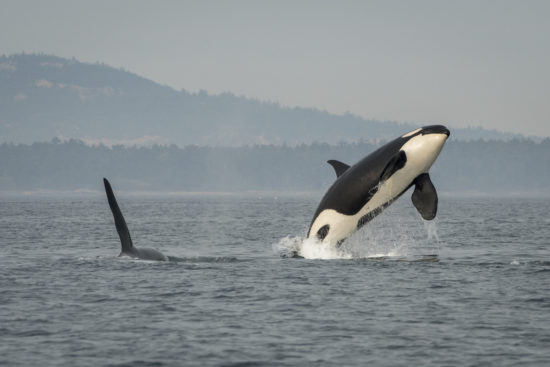
Task Force Makes Key Recommendations For Orcas, Chinook
Significantly increasing Chinook abundance to help out starving orcas is among the recommendations Washington’s Southern Resident Killer Whale Task Force voted to forward to Governor Jay Inslee yesterday.

Ron Garner of Puget Sound Anglers said it was a tough go with a lot of pushback from hatchery reformers, but he says a coalition of fishing interests got a recommendation that includes releasing as many as 50 million more smolts than were this year across the finish line.
“Butch Smith from Ilwaco, our tribes, and I pounded and pounded on that and finally got it in. WDFW’s Amy Windrope was key to helping me keeping it in and making sure it was supported by the Task Force. Without the bold statement that we endorse it, we most likely wouldn’t get anything out of it,” PSA’s statewide president said.
The governor and legislature must still buy into and fund Recommendation 6, which says any hatchery increases should be done in concert with habitat improvements, as well as be consistent with ESA constraints and management plans, but the lack of salmon — primarily Chinook — is one of the key reasons the orcas haven’t been doing well in recent years.
In an executive order this past March that also created the task force, Inslee began pushing the Washington Department of Fish and Wildlife to boost production of the salmon stock, and two months ago the agency temporarily closed salmon fishing on the Samish River to allow more broodstock to reach the hatchery.
The 50 million figure comes from the Fish and Wildlife Commission which in late summer expressed support for upping smolt releases from select facilities, 30 million in Puget Sound and 20 million in the Columbia.
Kings in both areas were identified in a joint state-federal study as key feed stocks for the southern residents, and it’s no secret that increasing production would also provide “shirttail benefits” for fishermen.
Tens of millions more used to be released in Puget Sound — 55 million by the state in 1989 alone — and elsewhere in the past, but those have tailed off as runs declined and Endangered Species Act listings and hatchery reforms came into play to try and recover wild returns. The plight of the fish, SRKWs and fishermen of all fleets are intertwined.

Garner said he had to “get way down into the weeds” to show that more than a dozen rivers in Puget Sound were stocked with more than 35 million Green River fall kings by the old Department of Fisheries alone in the 1980s, a figure he says doesn’t account for tribal and federal releases either.
“My point was that there are no wild gene pools left, as this is just one instance as we have been mixing stocks for over 100 years. The tribes backed me up and said our habitat is not going to come back anytime soon and hatcheries are the future until we can fix the millions of people moving into the Puget Sound (region) and losing more habitat,” he said.
“The tribes, WDFW, and a few sporties came together yesterday for a big win for the orcas and fishing!”
Garner was among the members of the task force who met on Election Tuesday in a “fishbowl” format at the state fairgrounds in Puyallup. The meeting was broadcast on TVW.
During the day-long confab and under the guidance of facilitator Susan Gulick, the group made slight tweaks to pinniped recommendations and essentially added more stakeholder process for residents and businesses potentially affected by Snake River dam removal.
Returning Idaho kings are important for orcas as they forage off the Washington Coast, researchers found by studying their doots, the dam-and-lock and hydropower systems an economic lifeline to the Inland Northwest.

One of the task force’s most immediately tweetworthy moves was to agree to recommend suspending southern resident killer whale watching for all fleets — commercial, recreational, kayak, rubber dingy, etc., etc., etc. — for the next three to five years.
Disturbance from vessels is another key factor in why orcas are struggling, but a draconian “no-go zone” around the west side of San Juan Island — whether whales were feeding in this critical foraging area or not — has been tabled in favor of a bubble approach.
“There is now going to be a closure around wherever J, K, and L Pods are,” reports Garner. “They will be monitored by WDFW boats and if they come into an area, everyone has to leave. The whale watchers were not happy, but J, K and L are only there 20 percent of the time.”
The recommendation would not affect watchers’ ability to view humpback whales or transient orcas in Puget Sound and elsewhere.

Next up is for the task force to send the governor its final report, due in mid-November, ahead of 2019’s legislative session, when lawmakers will need to fund many of the measures or enact laws to enforce them.
For WDFW task force member and Region 4 director Amy Windrope, the most important facet of this more than half-year-long process has been that the final recommendations had majority support from a diverse set of stakeholders and that the public turned out and joined the conversation.
And not just Puget Sound, Washington and Northwest residents, but people from as far away as England, Scotland and Germany.
“It was so powerful to hear the public talk about their love of orcas,” Windrope said.

